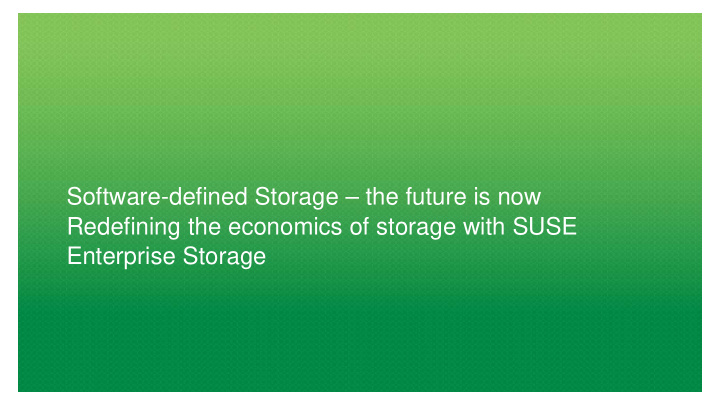



Software-defined Storage – the future is now Redefining the economics of storage with SUSE Enterprise Storage
SDS is More Than Just Vendor Hype By 2020, between 70% and 80% of unstructured data will be held on lower-cost storage managed by SDS Source: Gartner innovation insight: Separating Hype from Hop for Software-Defined Storage 2
Enterprise Data Capacity Utilization Tier 0 Ultra High Performance 1-3% Tier 1 15-20% High-value, OLTP, Revenue Generating Tier 2 Backup/Recovery, 20-25% Reference Data, Bulk Data [ user directories etc] Tier 3 Object, Archive, 50-60% Compliance Archive, of Enterprise Long-term Retention Data Source: Horison Information Strategies - Fred Moore 3
Why Deploy Software-defined Storage 4
Software-defined Storage The general availability of open source based, software-defined storage from Linux vendors like SUSE, marks the beginning of a new era of much more agile, scalable and cost-effective storage. Software-defined storage will displace traditional enterprise storage as the dominant storage architecture and therefore will create a strategic imperative for storage IT professionals. 5
Enterprise Storage Tomorrow • Differentiated “Tiered” Information ‒ Timely identification, classification and efficient placement of data • Software-based Storage (OPEX) ‒ Open, extensible, unified and simple • Industry-standard Hardware Building Blocks (CAPEX) ‒ Commodity off-the-shelf servers and disk drives 6
7
8
Why SUSE and Software-defined Storage Open source cloud operating systems and software-defined storage platforms are based on the Linux operating system. SUSE is a Linux OS pioneer and successful software vendor with thousands of installations. Customers should expect to receive nothing less than expert support from SUSE for their software-based storage. 9
SUSE Enterprise Storage Powered by CEPH • Most popular OpenStack distributed storage solution • Extensively scalable from gigabytes to petabytes • Storage appliance to cost-effective cloud solution • Industry-leading storage functionality • Built on clustered servers ‒ Self healing ‒ Self managing 10
Enterprise Class Capabilities • Unlimited scalability • Erasure coding for space-efficient resilience • Self repairing • Unified object, block and file • Cache tiering for performance [future] access • Thin provisioning for optimized • No disruptive scalability of utilization capacity online • Copy-on-write clones for • Rolling non-disruptive upgrades application rollback • Data-at-rest Encryption • Heterogeneous Operating System access 11
SUSE Storage Product Positioning High-end Disk Array Mid-range Array Fully Featured NAS Device Mid-range NAS Entry-level Disk Array SUSE Enterprise Storage JBOD Storage 12
SUSE Enterprise Storage Business Benefits SAVINGS: Total cost of ownership ‒ Reduced CAPEX expenditures ‒ Reduced OPEX expenditures ‒ Ease of management FLEXIBILITY: Adaptability to evolving business needs ‒ Reduced dependency upon proprietary “Locked In” storage CONFIDENCE: Reliability and availability ‒ Leverage SUSE world-class support and services 13
What Gartner is telling customers 14
Key Issues to Consider Beyond TCO 15
16
SUSE: A Long History in Data • SUSE Enterprise Storage customers will have confidence that the enterprise storage solutions they deploy are tightly integrated with SUSE Linux Enterprise Server. • SUSE Linux Enterprise Server has a long history of delivering leading data storage functionality to enterprise customers. • SUSE Linux Enterprise Server was first to provide a journaling file system followed by XFS. • SUSE Linux Enterprise Server provided first-to-market support for EXT3 and ReiserFS. • SUSE Linux Enterprise Server was the first to support a clustered file system with OCSF2. • SUSE Linux Enterprise Server was the first with support for the scalable, copy-on-write and the B-tree filesystem BtrFS. • SUSE has more than two decades experience delivering the data integrity enterprise customers demand. 18
Recommend
More recommend